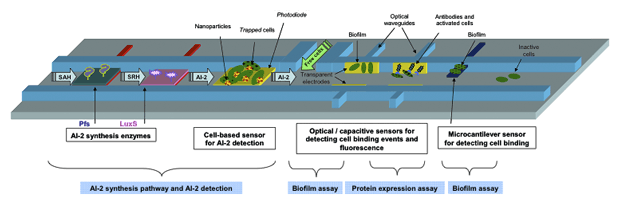The Biochip Project: Overview
SPECIFIC BIOLOGICAL APPLICATION AND AIMS: Autoinducer AI-2 Synthesis and Directed Cellular Response
Bacteria "communicate" among themselves to regulate gene expression at the community level. This communication is sensitive to population density and has been termed "quorum-sensing" . Initially discovered in two marine bioluminescent bacteria, Vibrio harveyi and Vibrio fischeri, quorum sensing is now reported among hundreds of species.
Quorum sensing (QS) is mediated by extracellular chemical signals known as "autoinducers" . As cells accumulate in number density, secreted autoinducers accumulate in their immediate surroundings, and at a point associated with a "quorum" of cells, these autoinducers are either transported back into the cells or recognized by membrane-bound surface receptors, where they initiate coordinated changes in gene regulation.
The biological system we propose to study is the synthesis and sensing of a bacterial autoinducer, AI-2, which has been described as a "universal signal" for interspecies bacterial communication. We have recently discovered that AI-2 controls biofilm formation in E. coli.
Biofilms are important in many areas of society, from industrial water systems to biomedical devices. There exists strong evidence for a link between AI-2 mediated quorum sensing and pathogenicity (reviewed by Vendeville et. al.). Because of the connectivity between AI-2 mediated quorum sensing, biofilm formation and pathogenesis, there exists a great need to understand fundamental mechanisms involved in AI-2 synthesis, uptake, signal transduction, mode-of-operation as a regulator, and as a determinant of phenotype. There are many unanswered questions: (i) what are the kinetics of AI-2 formation? (ii) how does the signal get transduced into a transcriptional response? (iii) how does the system architecture contribute to the QS biological "switch" ? (iv) are time domains and depth of the response (eg., numbers of genes) controlled by this regulation architecture? (v) how do individual cells respond to the autoinducer? (vi) how do individual cells contribute to the population phenotype?
Aims and Research Plan
Our research will interface, for the first time, the elements of the QS circuitry (e.g., the biosynthetic enzymes, the receptors, and the regulatory proteins) into a microelectromechanical system (MEMS). This will enable systematic study of biological activities using integrated multimodal sensing capabilities. The specific aims of our research plan are:
- Model genetic circuits for "rewiring" AI-2 Rrsponsive cells
- Adapt biology for signal-guided biofunctionalization and control
- "Tailored" microfabrication for biosystems
- Interface biology with surfaces
- Test the systems
Approach and Methodology
Establishing an experimental outcome as a biological fact requires the identical conclusion from experiments employing two or more fundamentally different techniques. Our intent is to measure many biological activities using fundamentally different measurements on the identical set of cells, at the same time. In MEMS, we can also validate by carrying out biological replicates in parallel.
It is our intent to guide the study of biology by learning from the device world. We demand predictability in the design, manufacture, and use of microfabricated devices, but biological systems are notoriously non-reproducible and the observed phenomena are often context dependent. We need to build experimental systems that incorporate biological components for the study of biology that are predictable. To accomplish this, we must devise techniques that embrace the fragility of biology and that that are designed to be used on-demand so that the most labile components are used quickly and reproducibly.
Figure 1 shows our concept for reconstructing the native AI-2 biosynthetic pathway in MEMS; entrapping "rewired" reporter cells that detect the functioning pathway; and studying the altered phenotype of the "guided" cells. A key aspect of our approach is that we can visualize individual cells that respond to different genetic outcomes (in the center chamber). We can do this by measuring green fluorescence emitted from individual cells. These cells respond to AI-2 and make green fluorescent protein (GFP), which is a reporter of a greater set of genes that are simultaneously upregulated. These genes (e.g., yadN, yadK, b0942, flu) facilitate cell attachment to surfaces and are the basis for biofilm formation. When we see a bright green cell, we should expect that individual cell to be "ready" to establish a biofilm. We can magnetically release all cells, and in the next chamber, capture the "ready" cells using a generic antibody-based capture system. The cells that are not green, should not have surface appendages, and should pass by. Then, we can measure the growth of the biofilm by capacitance, resistance, and by optical measurement, all at the same time. Our reusable MEMS technology allows us to then dry the film, remove it, and correlate it with the gold standard crystal violet assay that is accepted by the biological community. As a result, the measurements that are obtained on-chip can be cross-validated with biological experiments that are not from devices.
